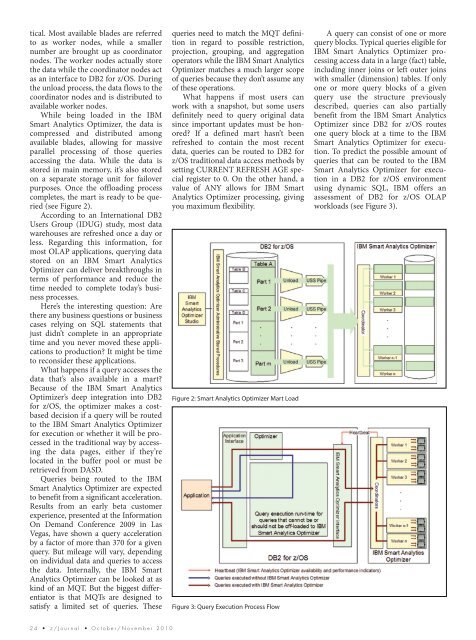z/VSE: 45 Years of Progress - z/VM - IBM
z/VSE: 45 Years of Progress - z/VM - IBM
z/VSE: 45 Years of Progress - z/VM - IBM
Create successful ePaper yourself
Turn your PDF publications into a flip-book with our unique Google optimized e-Paper software.
tical. Most available blades are referred<br />
to as worker nodes, while a smaller<br />
number are brought up as coordinator<br />
nodes. The worker nodes actually store<br />
the data while the coordinator nodes act<br />
as an interface to DB2 for z/OS. During<br />
the unload process, the data flows to the<br />
coordinator nodes and is distributed to<br />
available worker nodes.<br />
While being loaded in the <strong>IBM</strong><br />
Smart Analytics Optimizer, the data is<br />
compressed and distributed among<br />
available blades, allowing for massive<br />
parallel processing <strong>of</strong> those queries<br />
accessing the data. While the data is<br />
stored in main memory, it’s also stored<br />
on a separate storage unit for failover<br />
purposes. Once the <strong>of</strong>floading process<br />
completes, the mart is ready to be queried<br />
(see Figure 2).<br />
According to an International DB2<br />
Users Group (IDUG) study, most data<br />
warehouses are refreshed once a day or<br />
less. Regarding this information, for<br />
most OLAP applications, querying data<br />
stored on an <strong>IBM</strong> Smart Analytics<br />
Optimizer can deliver breakthroughs in<br />
terms <strong>of</strong> performance and reduce the<br />
time needed to complete today’s business<br />
processes.<br />
Here’s the interesting question: Are<br />
there any business questions or business<br />
cases relying on SQL statements that<br />
just didn’t complete in an appropriate<br />
time and you never moved these applications<br />
to production? It might be time<br />
to reconsider these applications.<br />
What happens if a query accesses the<br />
data that’s also available in a mart?<br />
Because <strong>of</strong> the <strong>IBM</strong> Smart Analytics<br />
Optimizer’s deep integration into DB2<br />
for z/OS, the optimizer makes a costbased<br />
decision if a query will be routed<br />
to the <strong>IBM</strong> Smart Analytics Optimizer<br />
for execution or whether it will be processed<br />
in the traditional way by accessing<br />
the data pages, either if they’re<br />
located in the buffer pool or must be<br />
retrieved from DASD.<br />
Queries being routed to the <strong>IBM</strong><br />
Smart Analytics Optimizer are expected<br />
to benefit from a significant acceleration.<br />
Results from an early beta customer<br />
experience, presented at the Information<br />
On Demand Conference 2009 in Las<br />
Vegas, have shown a query acceleration<br />
by a factor <strong>of</strong> more than 370 for a given<br />
query. But mileage will vary, depending<br />
on individual data and queries to access<br />
the data. Internally, the <strong>IBM</strong> Smart<br />
Analytics Optimizer can be looked at as<br />
kind <strong>of</strong> an MQT. But the biggest differentiator<br />
is that MQTs are designed to<br />
satisfy a limited set <strong>of</strong> queries. These<br />
queries need to match the MQT definition<br />
in regard to possible restriction,<br />
projection, grouping, and aggregation<br />
operators while the <strong>IBM</strong> Smart Analytics<br />
Optimizer matches a much larger scope<br />
<strong>of</strong> queries because they don’t assume any<br />
<strong>of</strong> these operations.<br />
What happens if most users can<br />
work with a snapshot, but some users<br />
definitely need to query original data<br />
since important updates must be honored?<br />
If a defined mart hasn’t been<br />
refreshed to contain the most recent<br />
data, queries can be routed to DB2 for<br />
z/OS traditional data access methods by<br />
setting CURRENT REFRESH AGE special<br />
register to 0. On the other hand, a<br />
value <strong>of</strong> ANY allows for <strong>IBM</strong> Smart<br />
Analytics Optimizer processing, giving<br />
you maximum flexibility.<br />
Figure 2: Smart Analytics Optimizer Mart Load<br />
Figure 3: Query Execution Process Flow<br />
A query can consist <strong>of</strong> one or more<br />
query blocks. Typical queries eligible for<br />
<strong>IBM</strong> Smart Analytics Optimizer processing<br />
access data in a large (fact) table,<br />
including inner joins or left outer joins<br />
with smaller (dimension) tables. If only<br />
one or more query blocks <strong>of</strong> a given<br />
query use the structure previously<br />
described, queries can also partially<br />
benefit from the <strong>IBM</strong> Smart Analytics<br />
Optimizer since DB2 for z/OS routes<br />
one query block at a time to the <strong>IBM</strong><br />
Smart Analytics Optimizer for execution.<br />
To predict the possible amount <strong>of</strong><br />
queries that can be routed to the <strong>IBM</strong><br />
Smart Analytics Optimizer for execution<br />
in a DB2 for z/OS environment<br />
using dynamic SQL, <strong>IBM</strong> <strong>of</strong>fers an<br />
assessment <strong>of</strong> DB2 for z/OS OLAP<br />
workloads (see Figure 3).<br />
2 4 • z / J o u r n a l • O c t o b e r / N o v e m b e r 2 0 1 0

















